Variability in Diurnal Internal Tides and Near-Inertial Waves in the Southern South China Sea Based on Mooring Observations
Abstract
1. Introduction
2. Materials and Methods
2.1. Data
2.2. Velocity Rotary Spectra
2.3. Calculation of Coherent and Incoherent Motions
3. Results
3.1. Evolution of Diurnal Internal Tides
3.2. Near-Inertial Waves Induced by Tropical Cyclone RAI (Event 1)
3.3. Near-Inertial Waves from November to December (Event 2)
3.4. Near-Inertial Waves Induced by Tropical Cyclone NOCK (Event 3)
4. Discussion
Author Contributions
Funding
Data Availability Statement
Acknowledgments
Conflicts of Interest
Abbreviations
| ITs | Internal tides |
| NIWs | Near-inertial waves |
| KE | Kinetic energy |
| TC | Tropical cyclone |
| feff | Effective inertial frequency |
| SCS | South China Sea |
| O1 | One of the diurnal tidal constituents |
| K1 | One of the diurnal tidal constituents |
| RAI | Tropical cyclone passed through the moorings in September 2016 |
| NOCK | Tropical cyclone passed through the moorings in December 2016 |
| CMEMS | Copernicus Marine Environment Monitoring Service |
| CCMP | Cross-Calibrated Multi-Platform |
| JTWC | Joint Typhoon Warning Center |
| ADCPs | Acoustic Doppler Current Profilers |
References
- Mohapatra, S.C.; Guedes Soares, C. Boussinesq Model for Two-Fluid System with Surface- and Interfacial Tension. Appl. Ocean Res. 2024, 152, 104183. [Google Scholar] [CrossRef]
- Alford, M.H.; Peacock, T.; MacKinnon, J.; Nash, J.D.; Buijsman, M.C.; Centurioni, L.R.; Chao, S.-Y.; Chang, M.-H.; Farmer, D.M.; Fringer, O.B.; et al. The formation and fate of internal waves in the South China Sea. Nature 2015, 521, 65–69. [Google Scholar] [CrossRef]
- Moehlis, J.; Smith, S.L. Radiation of Mixed Layer Near-Inertial Oscillations into the Ocean Interior. J. Phys. Oceanogr. 2001, 31, 1550–1560. [Google Scholar] [CrossRef]
- Jochum, M.; Briegleb, B.P.; Danabasoglu, G.; Large, W.G.; Norton, N.J.; Jayne, S.R.; Alford, M.H.; Bryan, F.O. The impact of oceanic near-inertial waves on climate. J. Clim. 2013, 26, 2833–2844. [Google Scholar] [CrossRef]
- Munk, W.; Wunsch, C. Abyssal recipes II: Energetics of tidal and wind mixing. Deep. Sea Res. Part I Oceanogr. Res. Pap. 1998, 45, 1977–2010. [Google Scholar] [CrossRef]
- Alford, M.H. Improved global maps and 54-year history of wind-work on ocean inertial motions. Geophys. Res. Lett. 2003, 30, 1424. [Google Scholar] [CrossRef]
- St. Laurent, L.; Garrett, C. The role of internal tides in mixing the deep ocean. J. Phys. Oceanogr. 2002, 32, 2882–2899. [Google Scholar] [CrossRef]
- Alford, M.H.; MacKinnon, J.A.; Simmons, H.L.; Nash, J.D. Near-inertial internal gravity waves in the ocean. Annu. Rev. Mar. Sci. 2016, 8, 95–123. [Google Scholar] [CrossRef] [PubMed]
- Price, J.F. Upper ocean response to a hurricane. J. Phys. Oceanogr. 1981, 11, 153–175. [Google Scholar] [CrossRef]
- Gill, A.E. On the behavior of internal waves in the wake of storms. J. Phys. Oceanogr. 1984, 14, 1129–1151. [Google Scholar] [CrossRef]
- D’Asaro, E.A.; Sanford, T.B.; Niiler, P.P.; Terrill, E.J. Cold wake of Hurricane Frances. Geophys. Res. Lett. 2007, 34, L15609. [Google Scholar] [CrossRef]
- Wunsch, C.; Ferrari, R. Vertical mixing, energy, and the general circulation of the oceans. Annu. Rev. Fluid Mech. 2004, 36, 281–314. [Google Scholar] [CrossRef]
- Duda, T.F.; Rainville, L. Diurnal and semidiurnal internal tide energy flux at a continental slope in the South China Sea. J. Geophys. Res. Oceans 2008, 113, C03025. [Google Scholar] [CrossRef]
- Chang, M.H.; Lien, R.C.; Tang, T.Y.; D’Asaro, E.A.; Yang, Y.J. Energy flux of nonlinear internal waves in northern South China Sea. Geophys. Res. Lett. 2006, 33, L03607. [Google Scholar] [CrossRef]
- Alford, M.H.; Zhao, Z. Global patterns of low-mode internal wave propagation. Part I: Energy and energy flux. J. Phys. Oceanogr. 2007, 37, 1829–1848. [Google Scholar] [CrossRef]
- Yang, Q.; Zhao, W.; Liang, X.; Tian, J. Three-Dimensional Distribution of Turbulent Mixing in the South China Sea. J. Phys. Oceanogr. 2016, 46, 769–788. [Google Scholar] [CrossRef]
- Zhao, Z. Southward Internal Tides in the Northeastern South China Sea. J. Geophys. Res. Oceans 2020, 125, e2020JC016324. [Google Scholar] [CrossRef]
- Zhao, Z. Internal tide radiation from the Luzon Strait. J. Geophys. Res. Oceans 2014, 119, 5434–5448. [Google Scholar] [CrossRef]
- Liang, H. Observational Study on the Internal Tides and Near-Inertial Internal Waves in the Northern South China Sea. Ph.D. Thesis, Ocean University of China, Qingdao, China, 2015. [Google Scholar]
- Xu, Z.; Liu, K.; Yin, B.; Zhao, Z.; Wang, Y.; Li, Q. Long-range propagation and associated variability of internal tides in the South China Sea. J. Geophys. Res. Oceans 2016, 121, 8268–8286. [Google Scholar] [CrossRef]
- Zaron, E.D. Mapping the nonstationary internal tide with satellite altimetry. J. Geophys. Res. Oceans 2017, 122, 539–554. [Google Scholar] [CrossRef]
- Song, P.; Chen, X. Investigation of the internal tides in the Northwest Pacific Ocean considering the background circulation and stratification. J. Phys. Oceanogr. 2020, 50, 3113–3133. [Google Scholar] [CrossRef]
- Guan, S.; Jin, F.-F.; Tian, J.; Lin, I.-I.; Pun, I.-F.; Zhao, W.; Huthnance, J.; Xu, Z.; Cai, W.; Jing, Z.; et al. Ocean Internal Tides Suppress Tropical Cyclones in the South China Sea. Nat. Commun. 2024, 15, 3903. [Google Scholar] [CrossRef] [PubMed]
- Liu, P.; Guan, S.; Lin, I.-I.; Huang, M.; Jin, F.; Wang, Q.; Lu, Z.; Zhao, W.; Tian, J. Response and Feedback of Mesoscale Eddies to Tropical Cyclones over the South China Sea. J. Geophys. Res. Atmos. 2025, 130, e2024JD041414. [Google Scholar] [CrossRef]
- Wan, Y.-J.; Chen, G.-X.; Shu, Y.-Q.; Wang, Q.; Chen, R.-Y.; Wang, D.-X. Near-Inertial Oscillations Induced by Tropical Cyclones under the Background of South China Sea Winter Monsoon Surge: A Case Study of Mirinae (0921). J. Trop. Oceanogr. 2015, 34, 11–18. [Google Scholar] [CrossRef]
- Chen, G.; Xue, H.; Wang, D.; Xie, Q. Observed near-inertial kinetic energy in the northwestern South China Sea. J. Geophys. Res. Oceans 2013, 118, 4965–4977. [Google Scholar] [CrossRef]
- Li, J.; Xu, J.; Liu, J.; He, Y.; Chen, Z.; Cai, S. Correlation of near-inertial wind stress in typhoon and typhoon-induced oceanic near-inertial kinetic energy in the upper South China Sea. Atmosphere 2019, 10, 388. [Google Scholar] [CrossRef]
- Liu, Q.; Cui, J.; Shang, X.; Xie, X.; Wu, X.; Gao, J.; Mei, H. Observation of Near-Inertial Internal Gravity Waves in the Southern South China Sea. Remote Sens. 2023, 15, 368. [Google Scholar] [CrossRef]
- Mao, H.; Qi, Y.; Chen, Y.; Yu, J. Enhanced Mixing Induced by Near-Inertial Waves Inferred by Glider Observation in the Northern South China Sea. J. Mar. Sci. Eng. 2023, 11, 2141. [Google Scholar] [CrossRef]
- Yang, B.; Hu, P.; Hou, Y. Observed Near-Inertial Waves in the Northern South China Sea. Remote Sens. 2021, 13, 3223. [Google Scholar] [CrossRef]
- Lee, D.K.; Niiler, P.P. The inertial chimney: The near-inertial energy drainage from the ocean surface to the deep layer. J. Geophys. Res. Oceans 1998, 103, 7579–7591. [Google Scholar] [CrossRef]
- Martínez-Marrero, A.; Barceló-Llull, B.; Pallàs-Sanz, E.; Aguiar-González, B.; Estrada-Allis, S.N.; Gordo, C.; Grisolía, D.; Rodríguez-Santana, A.; Arístegui, J. Near-Inertial Wave Trapping Near the Base of an Anticyclonic Mesoscale Eddy Under Normal Atmospheric Conditions. J. Geophys. Res. Oceans 2019, 124, 8455–8467. [Google Scholar] [CrossRef]
- Conn, S.; Fitzgerald, J.; Callies, J. Interpreting Observed Interactions Between Near-Inertial Waves and Mesoscale Eddies. J. Phys. Oceanogr. 2023, 54, 485–502. [Google Scholar] [CrossRef]
- Lelong, M.-P.; Cuypers, Y.; Bouruet-Aubertot, P. Near-inertial energy propagation inside a Mediterranean anticyclonic eddy. J. Phys. Oceanogr. 2020, 50, 2271–2288. [Google Scholar] [CrossRef]
- Zhao, B.; Liu, Z.; Xu, Z.; Yin, B.; Zheng, Q. Spontaneous near-inertial wave generation from mesoscale eddy: Nonlinear forcing mechanism. Phys. Fluids 2023, 35, 076609. [Google Scholar] [CrossRef]
- Kunze, E.; Schmitt, R.W.; Toole, J.M. The energy balance in a warm-core ring’s near-inertial critical layer. J. Phys. Oceanogr. 1995, 25, 942–957. [Google Scholar] [CrossRef]
- Zhai, X.; Greatbatch, R.J.; Zhao, J. Enhanced vertical propagation of storm-induced near-inertial energy in an eddying ocean channel model. Geophys. Res. Lett. 2005, 32, L18602. [Google Scholar] [CrossRef]
- Xu, X.; Zhao, W.; Huang, X.; Hu, Q.; Guan, S.; Zhou, C.; Tian, J. Observed Near-Inertial Waves Trapped in a Propagating Anticyclonic Eddy. J. Phys. Oceanogr. 2022, 52, 2029–2043. [Google Scholar] [CrossRef]
- Xie, X.; Shang, X.; Chen, G. Nonlinear interactions among internal tidal waves in the northeastern South China Sea. Chin. J. Oceanol. Limnol. 2010, 28, 996–1001. [Google Scholar] [CrossRef]
- Xie, X.; Shang, X.; Haren, H.V.; Chen, G. Observations of enhanced nonlinear instability in the surface reflection of internal tides. Geophys. Res. Lett. 2013, 40, 1580–1586. [Google Scholar] [CrossRef]
- Guan, S.; Zhao, W.; Huthnance, J.; Tian, J.; Wang, J. Observed upper ocean response to typhoon Megi (2010) in the Northern South China Sea. J. Geophys. Res. Oceans 2014, 119, 3134–3157. [Google Scholar] [CrossRef]
- Liu, Q.; Xie, X.; Shang, X.; Chen, G. Coherent and incoherent internal tides in the southern South China Sea. Chin. J. Oceanol. Limnol. 2016, 34, 1374–1382. [Google Scholar] [CrossRef]
- Chen, Z.; Ren, Q.; Nan, F.; Wang, J.; Xu, A.; Yu, F. Quality Control of Deep-Sea Mooring ADCP Data Processing. J. Ocean Univ. China 2021, 20, 8. [Google Scholar]
- Chen, G.; Hou, Y.; Zhang, Q.; Chu, X. The eddy pair off eastern Vietnam: Interannual variability and impact on thermohaline structure. Cont. Shelf Res. 2010, 30, 715–723. [Google Scholar] [CrossRef]
- Mears, C.; Lee, T.; Ricciardulli, L.; Wang, X.; Wentz, F. Improving the Accuracy of the Cross-Calibrated Multi-Platform (CCMP) Ocean Vector Winds. Remote Sens. 2022, 14, 4230. [Google Scholar] [CrossRef]
- Gonella, J. A rotary-component method for analysing meteorological and oceanographic vector time series. Deep Sea Res. Oceanogr. Abstr. 1972, 19, 833–846. [Google Scholar] [CrossRef]
- Dronkers, J.J. Tidal Computations in Rivers and Coastal Waters; North-Holland: Amsterdam, The Netherlands, 1964. [Google Scholar]
- Shang, X.; Liu, Q.; Xie, X.; Chen, G.; Chen, R. Characteristics and seasonal variability of internal tides in the southern South China Sea. Deep-Sea Res. Part I Oceanogr. Res. Pap. 2015, 98, 43–52. [Google Scholar] [CrossRef]
- Pan, H.; Lv, X.; Wang, Y.; Matte, P.; Chen, H.; Jin, G. Exploration of tidal-fluvial interaction in the Columbia River estuary using S_TIDE. J. Geophys. Res. Oceans 2018, 123, 6598–6619. [Google Scholar] [CrossRef]
- Wang, Y.; Guan, S.; Zhang, Z.; Zhou, C.; Xu, X.; Guo, C.; Zhao, W.; Tian, J. Observations of parametric subharmonic instability of diurnal internal tides in the Northwest Pacific. J. Phys. Oceanogr. 2024, 54, 849–870. [Google Scholar] [CrossRef]

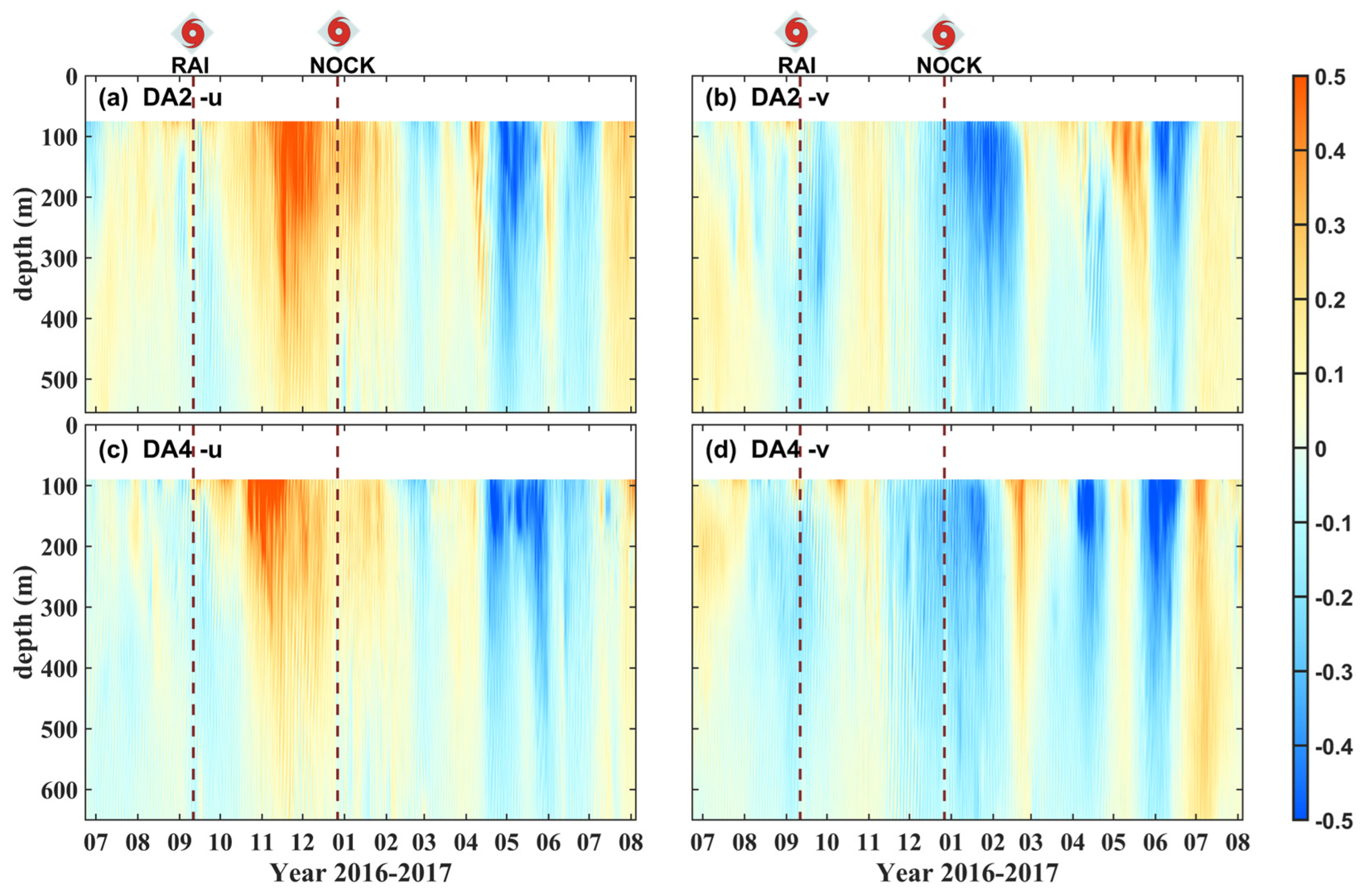
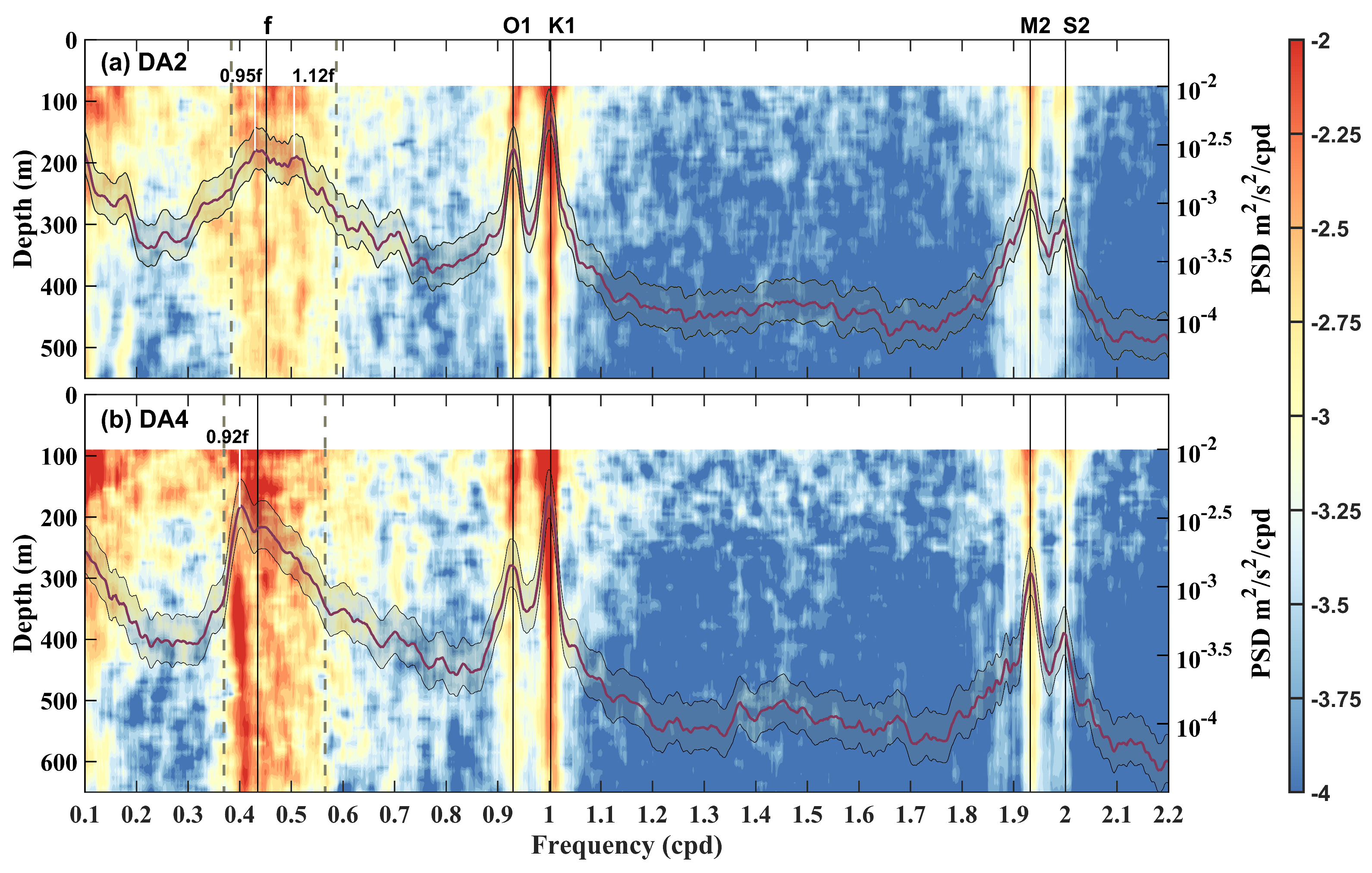
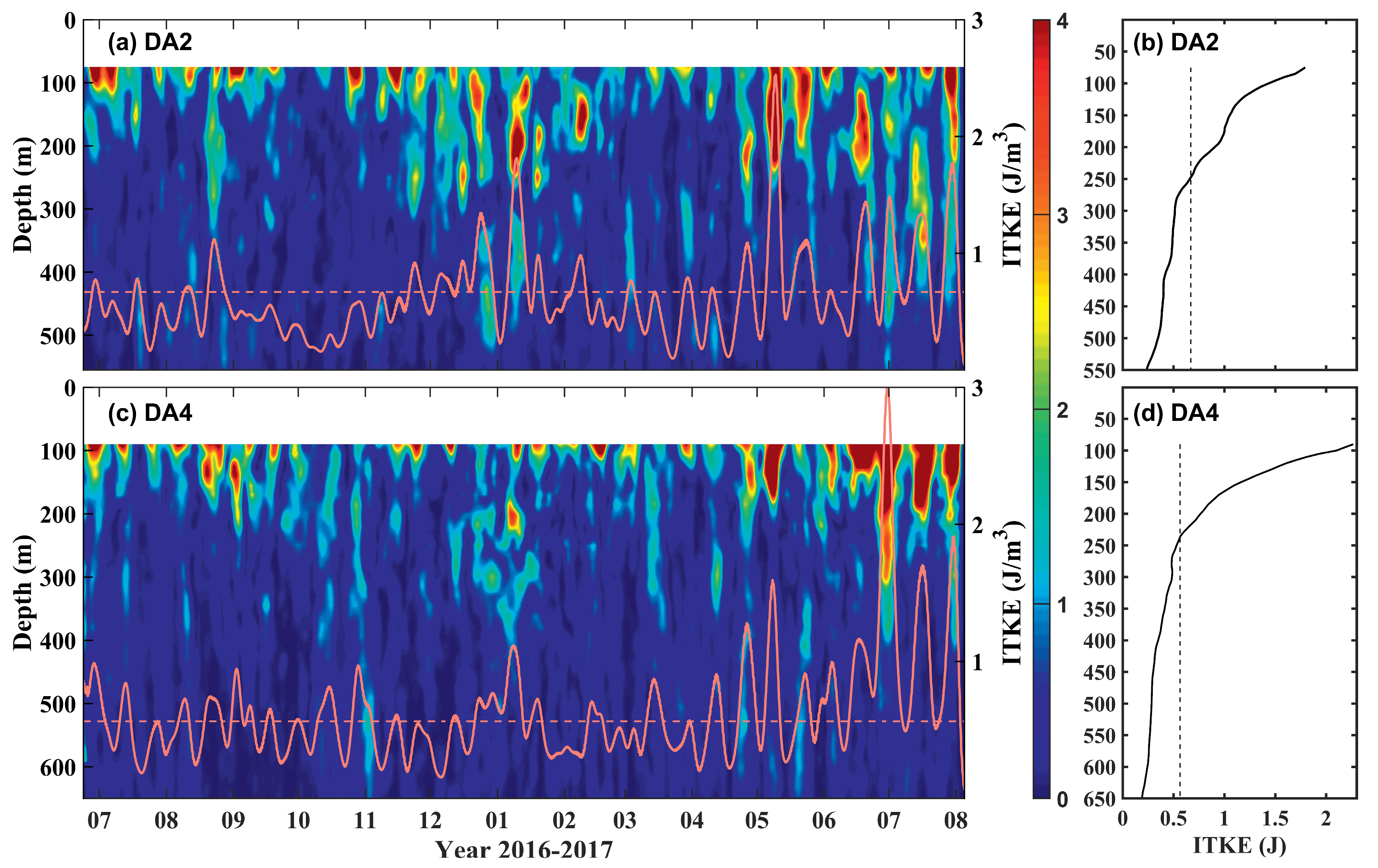
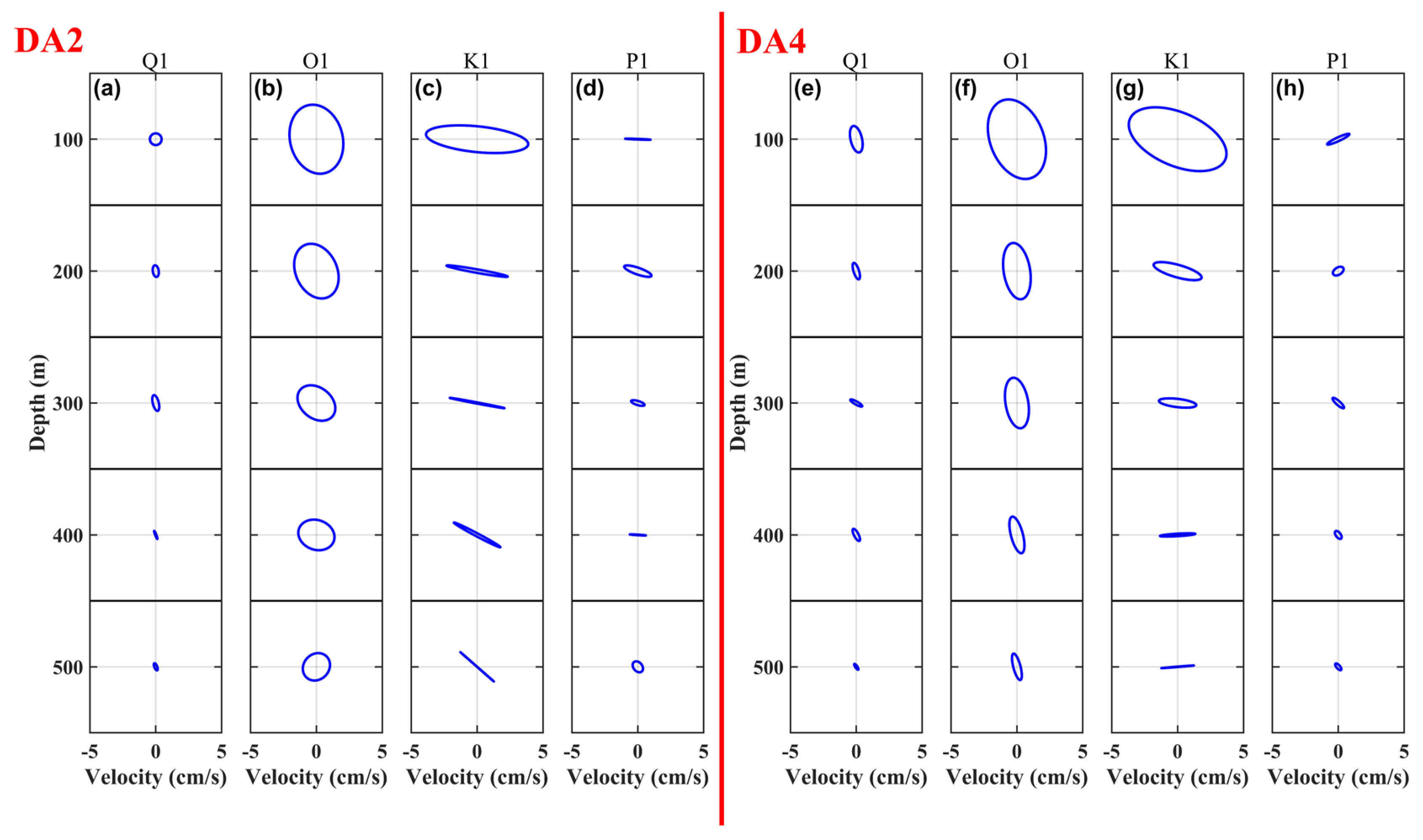
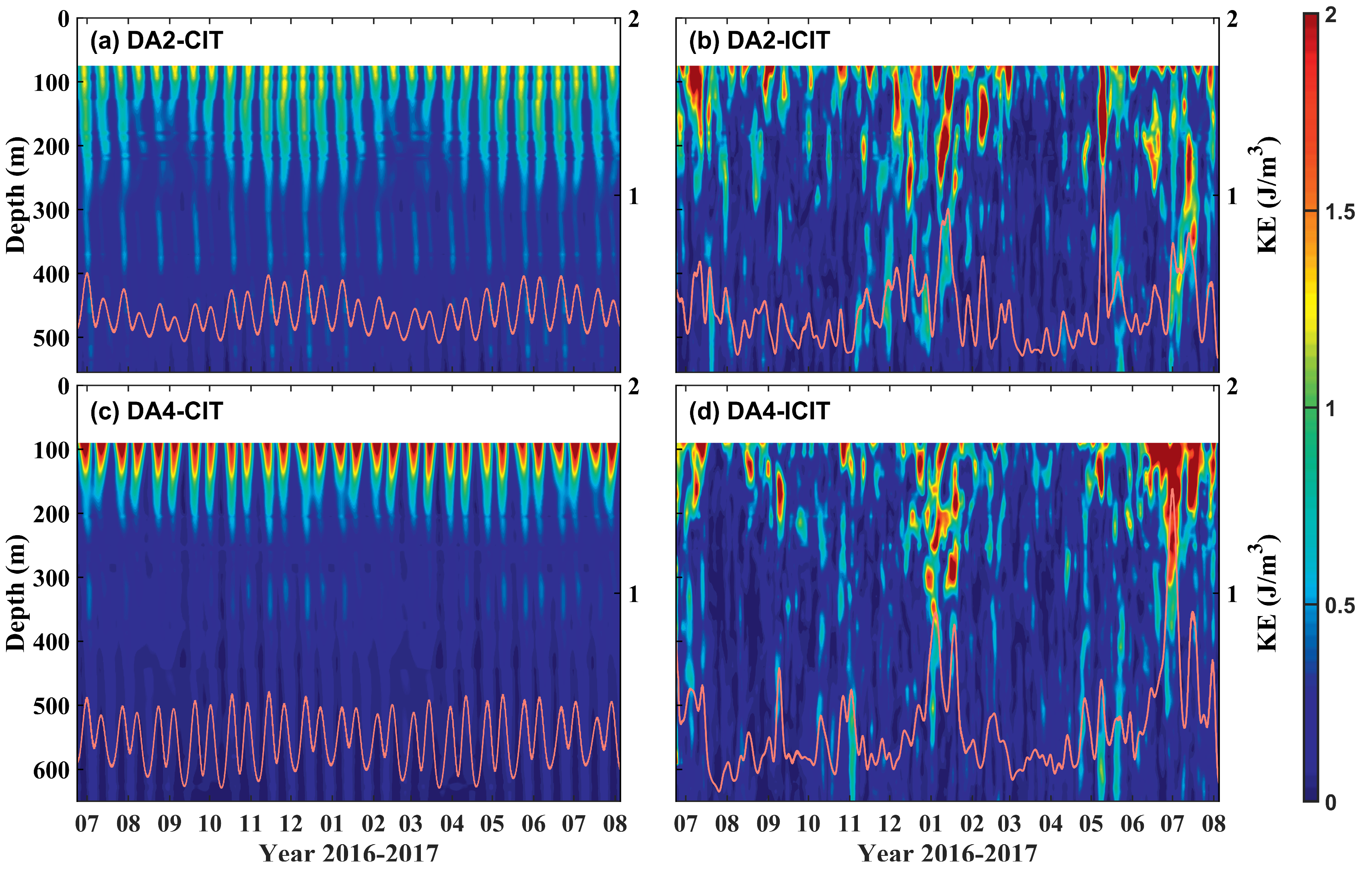
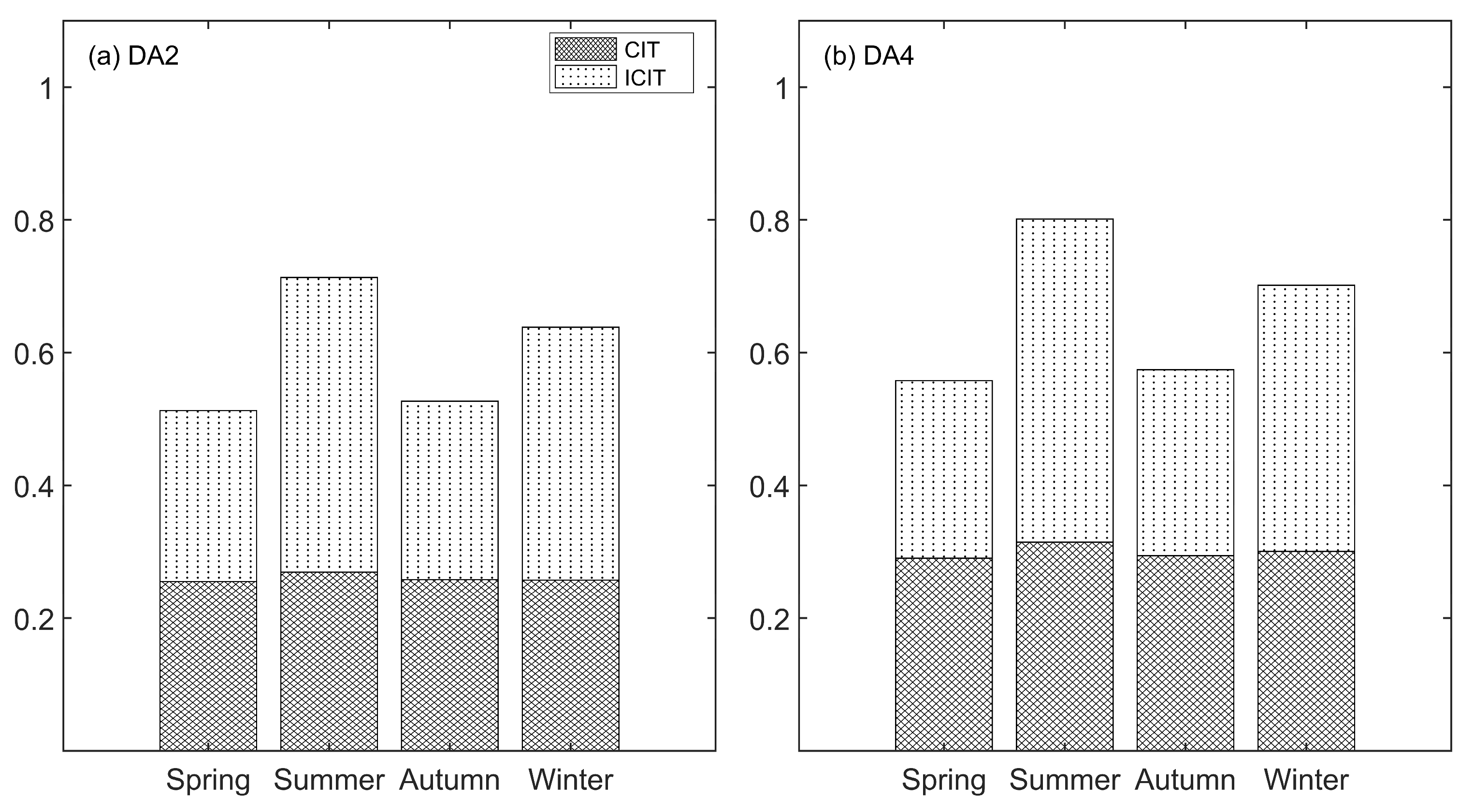
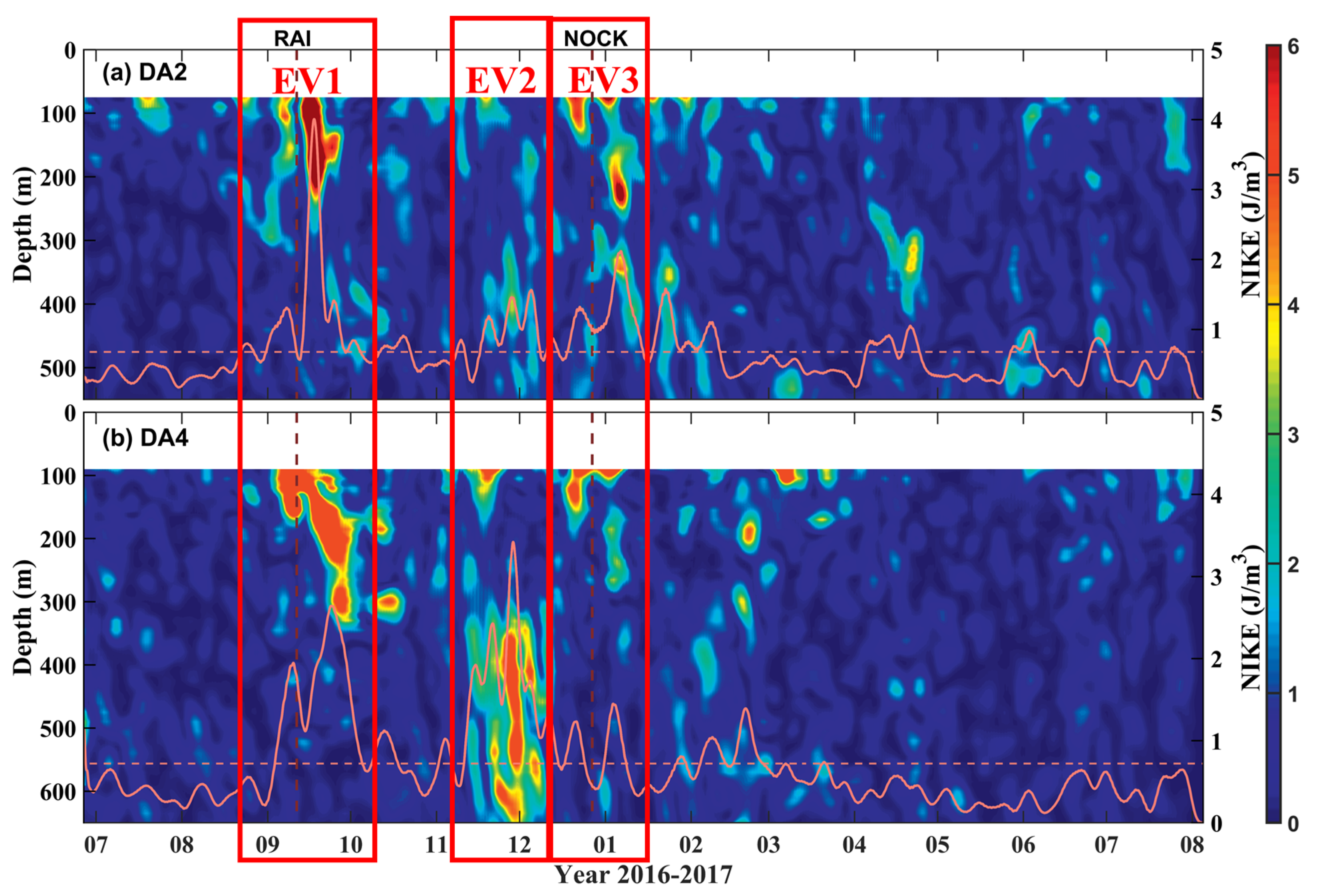
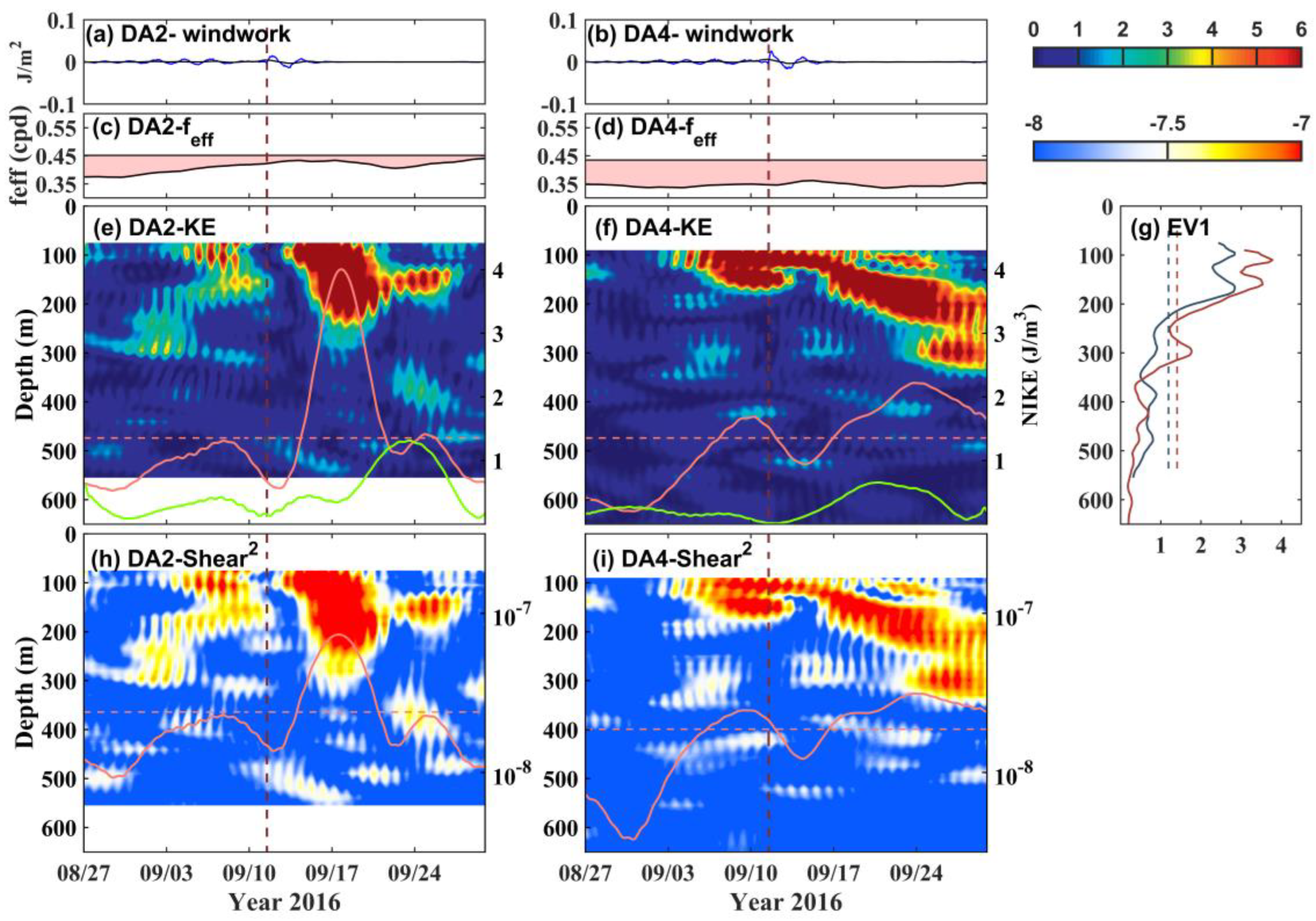
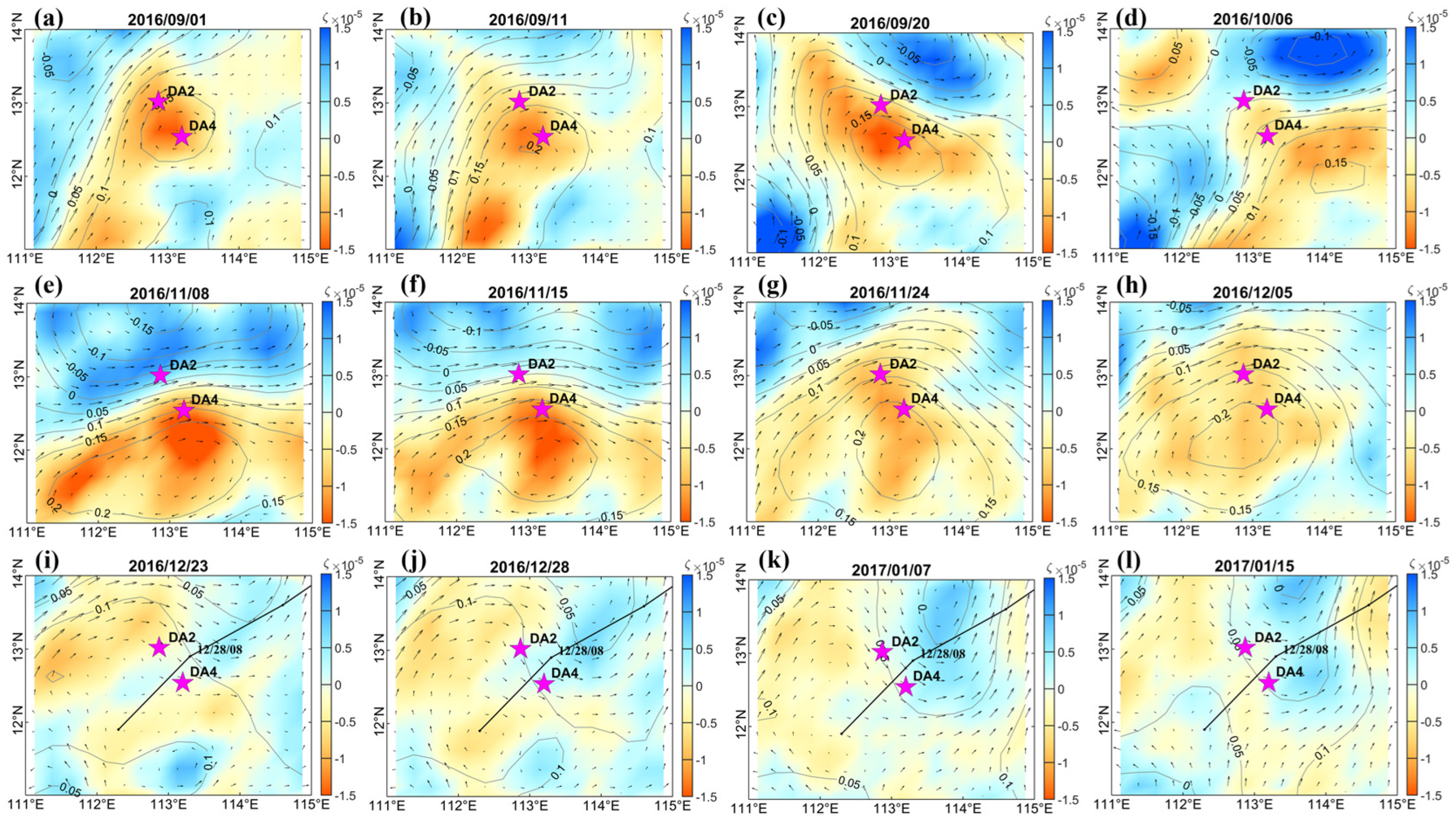
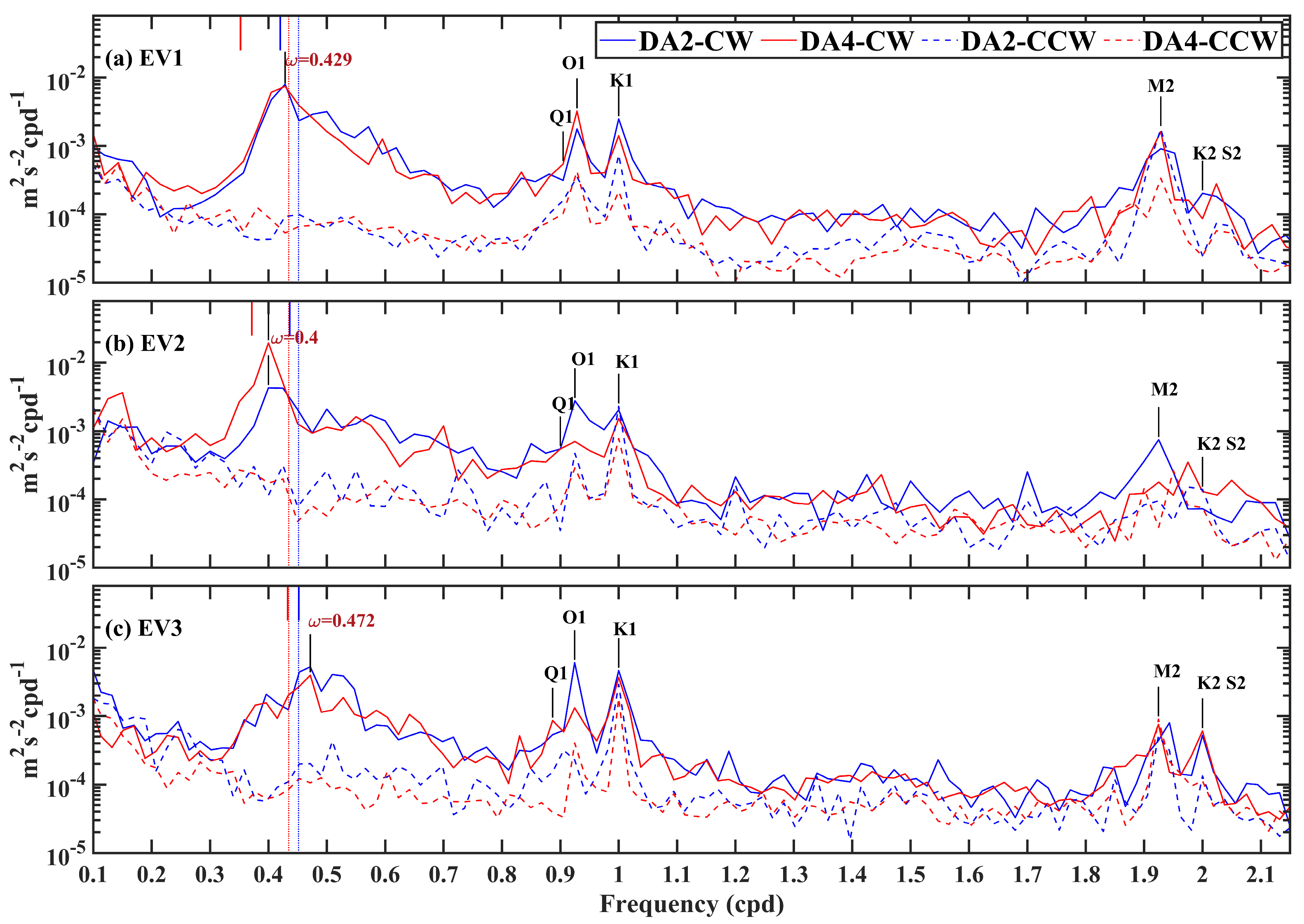
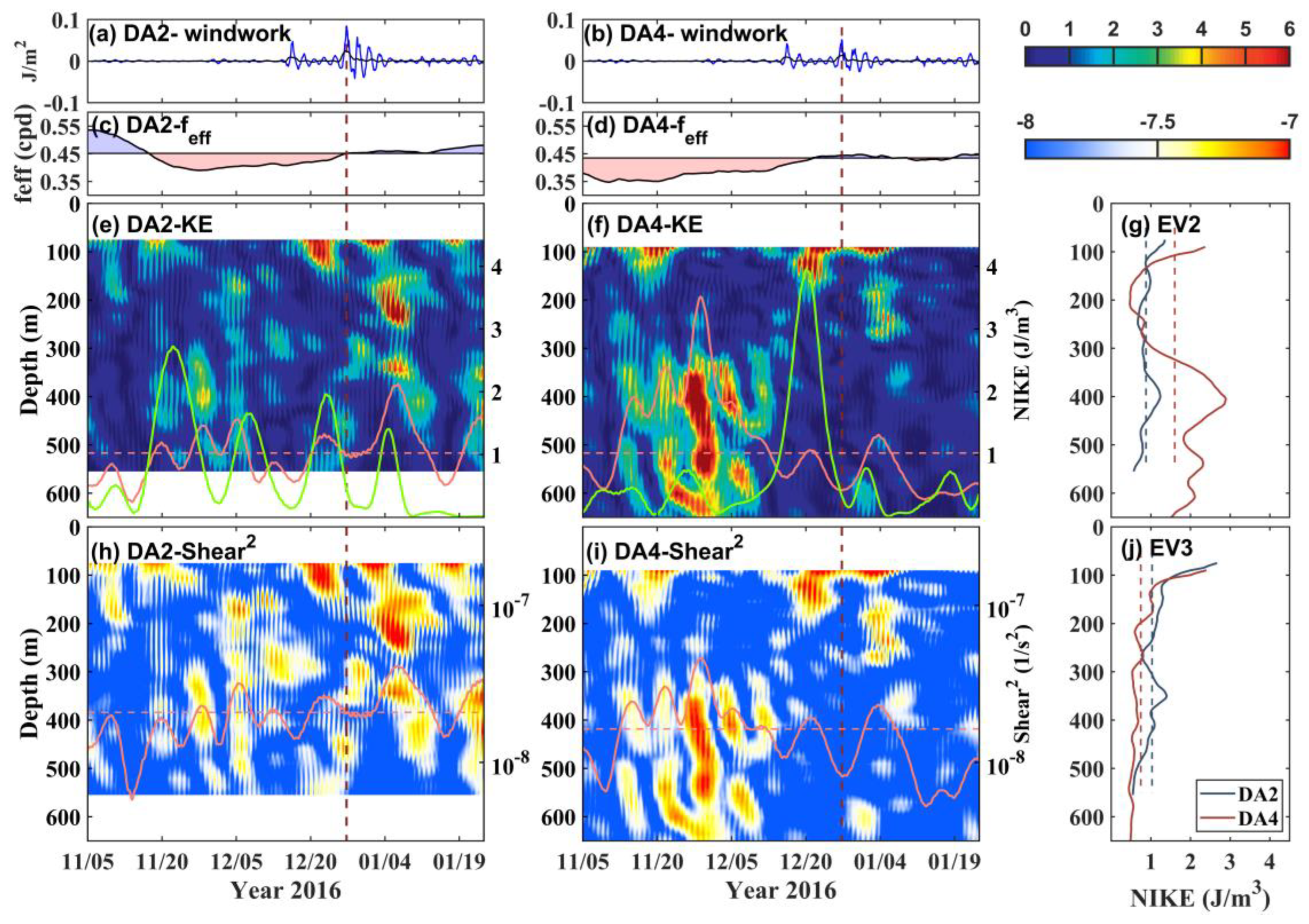
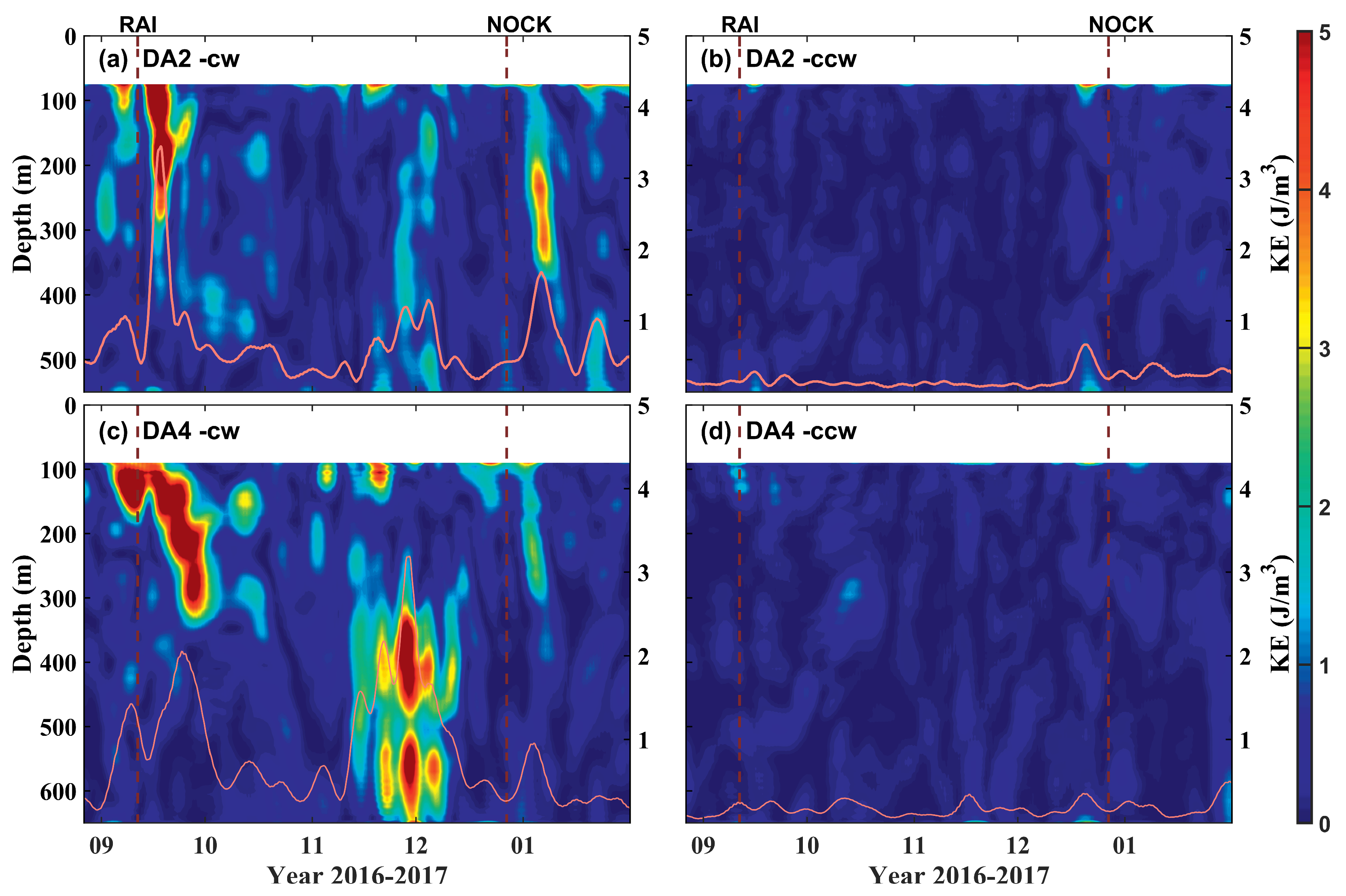
| Morring | ADCP (up) | RCM | NTK | RCM | NTK | RCM |
|---|---|---|---|---|---|---|
| DA2 | 550 m | 1000 m | 2000 m | 2500 m | 3000 m | 3500 m |
| DA4 | 650 m | 1150 m | 2150 m | 3150 m | 3650 m | 4150 m |
Disclaimer/Publisher’s Note: The statements, opinions and data contained in all publications are solely those of the individual author(s) and contributor(s) and not of MDPI and/or the editor(s). MDPI and/or the editor(s) disclaim responsibility for any injury to people or property resulting from any ideas, methods, instructions or products referred to in the content. |
© 2025 by the authors. Licensee MDPI, Basel, Switzerland. This article is an open access article distributed under the terms and conditions of the Creative Commons Attribution (CC BY) license (https://creativecommons.org/licenses/by/4.0/).
Share and Cite
Zhang, Y.; Wang, Y.; Wang, C.; Guan, S.; Zhao, W. Variability in Diurnal Internal Tides and Near-Inertial Waves in the Southern South China Sea Based on Mooring Observations. J. Mar. Sci. Eng. 2025, 13, 577. https://doi.org/10.3390/jmse13030577
Zhang Y, Wang Y, Wang C, Guan S, Zhao W. Variability in Diurnal Internal Tides and Near-Inertial Waves in the Southern South China Sea Based on Mooring Observations. Journal of Marine Science and Engineering. 2025; 13(3):577. https://doi.org/10.3390/jmse13030577
Chicago/Turabian StyleZhang, Yilin, Yifan Wang, Chen Wang, Shoude Guan, and Wei Zhao. 2025. "Variability in Diurnal Internal Tides and Near-Inertial Waves in the Southern South China Sea Based on Mooring Observations" Journal of Marine Science and Engineering 13, no. 3: 577. https://doi.org/10.3390/jmse13030577
APA StyleZhang, Y., Wang, Y., Wang, C., Guan, S., & Zhao, W. (2025). Variability in Diurnal Internal Tides and Near-Inertial Waves in the Southern South China Sea Based on Mooring Observations. Journal of Marine Science and Engineering, 13(3), 577. https://doi.org/10.3390/jmse13030577





